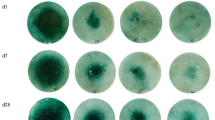Abstract
Response of corn (Zea mays L.) to fine and granular Mg fertilizers was determined on an acid, Mg-deficient Weston fine sand (Typic Ochraquults) in a greenhouse pot experiment. Corn forage yields were similar with finely ground (< 0.2 mm) MgSO4, MgO, MgCO3, and Mg-oxysulfate (a partly acidulated MgO product). Granular MgSO4 (100% water-soluble) was as effective as the finely ground products. Forage yields with granular MgO and Mg-oxysulfate were related to their granule size. Small (1.4 to 2.0 mm) granules were almost as effective as the finely ground fertilizers, but medium (2.4 to 3.4 mm) and coarse (3.4 to 4.8 mm) granules were increasingly less effective. Magnesium uptake by corn generally increased as forage yields increased.
After the first crop harvest, the soil was kept moist for 16 weeks. More NPK fertilizer was applied and the soil in each pot was mixed and repotted. A second crop of corn was grown to determine residual effects of the applied Mg fertilizers. Forage yields were similar with all granular and finely ground Mg fertilizers. These results suggest that while immediate availability to plants of relatively insoluble MgO is inversely related to granule size, residual availabiity of all granular and finely ground fertilizers was similar. Such granular Mg fertilizers could be bulk blended with NPK fertilizers to maintain available Mg levels in soils.
Similar content being viewed by others
References
Christenson DR (1987) Essential element magnesium is involved in metabolism. Custom Applicator 17(3): 70–73
Christenson DR, White RP and Doll EC (1973) Yields and magnesium uptake as affected by soil pH and calcium levels. Agron J 65: 205–206
Engelstad OP (1968) Use of multiple regression in fertilizer evaluation. Agron J 60: 327–329
Farina MFW, Sumner ME, Plank CO and Letzsch WS (1980) Effect of pH on soil magnesium and its absorption by corn. Comm Soil Sci Plant Anal 11: 981–992
Fox RH and Piekielek WP (1984) Soil magnesium level, corn (Zea mays L.) yield, and magnesium uptake. Comm Soil Sci Plant Anal 15: 109–123
Hossner LR and Doll EC (1970) Magnesium fertilization of potatoes as related to liming and potassium. Soil Sci Soc Am Proc 34: 772–774
Jacob A (1958) Magnesium, the fifth major plant nutrient. 159 pp. London: Staples Press Ltd
Jones, Jr. JB, Blount MC and Wilkinson SR (1972). Magnesium in the environment. 380 pp. Reynolds, Georgia, USA: Taylor County Publishing Co
Mortvedt, JJ and Cox FR (1985) Production, marketing and use of calcium, magnesium and micronutrient fertilizers. In: Engelstad OP (ed) Fertilizer technology and use. Third edn pp. 455–481. Madison, Wisconsin: Soil Sci Soc Am
Usherwood NR and Miller JR (1967) Effect of soil pH on the availability of magnesium to corn (Zea mays L.) from magnesium sulfate and high magnesium liming materials. Soil Sci Soc Am Proc 31: 390–393
Wolf P (1963) Evaluation of calcined magnesite as a source of magnesium for plants. Agron J 55: 261–262
Author information
Authors and Affiliations
Rights and permissions
About this article
Cite this article
Mortvedt, J.J., Kelsoe, J.J. Crop response to fine and granular magnesium fertilizers. Fertilizer Research 15, 155–161 (1988). https://doi.org/10.1007/BF01050677
Accepted:
Issue Date:
DOI: https://doi.org/10.1007/BF01050677




